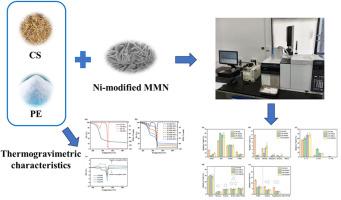镍改性多层MFI纳米片用于玉米秸秆与聚乙烯共热解制备富烃产物
IF 4.7
3区 材料科学
Q1 CHEMISTRY, APPLIED
引用次数: 0
摘要
合成了不同Ni负载比(3、6、10 wt%)的多层MFI纳米片(MMN),制备了富烃产品。热重分析表明,玉米秸秆(CS)与聚乙烯(PE)以3:2的比例混合,具有明显的增效作用。采用Py-GC/MS研究了不同剂量的MMN和不同镍负载对热解产物的影响。单环芳烃(Monocyclic aromatic hydrocarbons, MAHs)在CP2M时开始检出,达到最大值30.08%,而含氧化合物(OCCs)较CPNC减少43.75%。不同的Ni负载率进一步增强了MMNs的脱氧能力,低Ni负载率(3 wt%)的MMNs的OCCs相对含量最低,为3.67%。Ni的引入改变了MMN的B/L比,从而抑制了多环芳烃(PAHs)的生成。本研究为金属改性MMN生物质热解制备富烃燃料提供了一条新的途径。本文章由计算机程序翻译,如有差异,请以英文原文为准。

Ni-modified multilayer MFI nanosheets for co-pyrolysis of corn stover and polyethylene to prepare hydrocarbon-rich products
Multilayer MFI nanosheets (MMN) with different Ni loading ratios (3, 6, 10 wt%) were synthesized to prepare hydrocarbon-rich products. In view of the thermogravimetric analysis, A mixture of corn stover (CS) and polyethylene (PE) in a ratio of 3:2 exhibits a pronounced synergistic effect. The effects of different doses of MMN and different nickel loadings on pyrolysis products were studied using Py-GC/MS. Monocyclic aromatic hydrocarbons (MAHs) began to be detected and reached a maximum value of 30.08 % at CP2M, while oxygen-containing compounds (OCCs) decreased by 43.75 % compared to CPNC. The deoxygenation ability of MMNs was further enhanced with different Ni loading ratios, with MMNs having a low Ni loading ratio (3 wt%) achieving the minimum relative content of OCCs at 3.67 %. The introduction of Ni species altered the B/L ratio of MMN, thereby inhibiting the generation of polycyclic aromatic hydrocarbons (PAHs). This work provided a new pathway for preparing hydrocarbon-rich fuels from biomass pyrolysis by using metal-modified MMN.
求助全文
通过发布文献求助,成功后即可免费获取论文全文。
去求助
来源期刊

Microporous and Mesoporous Materials
化学-材料科学:综合
CiteScore
10.70
自引率
5.80%
发文量
649
审稿时长
26 days
期刊介绍:
Microporous and Mesoporous Materials covers novel and significant aspects of porous solids classified as either microporous (pore size up to 2 nm) or mesoporous (pore size 2 to 50 nm). The porosity should have a specific impact on the material properties or application. Typical examples are zeolites and zeolite-like materials, pillared materials, clathrasils and clathrates, carbon molecular sieves, ordered mesoporous materials, organic/inorganic porous hybrid materials, or porous metal oxides. Both natural and synthetic porous materials are within the scope of the journal.
Topics which are particularly of interest include:
All aspects of natural microporous and mesoporous solids
The synthesis of crystalline or amorphous porous materials
The physico-chemical characterization of microporous and mesoporous solids, especially spectroscopic and microscopic
The modification of microporous and mesoporous solids, for example by ion exchange or solid-state reactions
All topics related to diffusion of mobile species in the pores of microporous and mesoporous materials
Adsorption (and other separation techniques) using microporous or mesoporous adsorbents
Catalysis by microporous and mesoporous materials
Host/guest interactions
Theoretical chemistry and modelling of host/guest interactions
All topics related to the application of microporous and mesoporous materials in industrial catalysis, separation technology, environmental protection, electrochemistry, membranes, sensors, optical devices, etc.
 求助内容:
求助内容: 应助结果提醒方式:
应助结果提醒方式:


